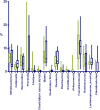Taxonomic Characterization and Short-Chain Fatty Acids Production of the Obese Microbiota
- PMID: 34222034
- PMCID: PMC8242951
- DOI: 10.3389/fcimb.2021.598093
Taxonomic Characterization and Short-Chain Fatty Acids Production of the Obese Microbiota
Erratum in
-
Erratum: Taxonomic Characterization and Short-Chain Fatty Acids Production of the Obese Microbiota.Front Cell Infect Microbiol. 2021 Oct 12;11:781260. doi: 10.3389/fcimb.2021.781260. eCollection 2021. Front Cell Infect Microbiol. 2021. PMID: 34712625 Free PMC article.
Abstract
Intestinal microbiota seems to play a key role in obesity. The impact of the composition and/or functionality of the obesity-associated microbiota have yet to be fully characterized. This work assessed the significance of the taxonomic composition and/or metabolic activity of obese- microbiota by massive 16S rRNA gene sequencing of the fecal microbiome of obese and normoweight individuals. The obese metabolic activity was also assessed by in vitro incubation of obese and normoweight microbiotas in nutritive mediums with different energy content. We found that the microbiome richness and diversity of the two groups did not differ significantly, except for Chao1 index, significantly higher in normoweight individuals. At phylum level, neither the abundance of Firmicutes or Bacteroidetes nor their ratio was associated with the body mass index. Besides, the relative proportions in Collinsella, Clostridium XIVa, and Catenibacterium were significantly enriched in obese participants, while Alistipes, Clostridium sensu stricto, Romboutsia, and Oscillibacter were significantly diminished. In regard to metabolic activity, short-chain fatty acids content was significant higher in obese individuals, with acetate being the most abundant followed by propionate and butyrate. Acetate and butyrate production was also higher when incubating obese microbiota in mediums mimicking diets with different energy content; interestingly, a reduced capability of propionate production was associated to the obese microbiome. In spite of the large interindividual variability, the obese phenotype seems to be defined more by the abundance and/or the absence of distinct communities of microorganism rather than by the presence of a specific population.
Keywords: diversity; in vitro incubations; metabolic activity; microbiota; obesity; short-chain fatty acids.
Copyright © 2021 Martínez-Cuesta, del Campo, Garriga-García, Peláez and Requena.
Conflict of interest statement
The authors declare that the research was conducted in the absence of any commercial or financial relationships that could be construed as a potential conflict of interest.
Figures

 ) and obese (O,
) and obese (O,  ) individuals at family (A) and genus (B) taxonomical levels. The median, minimum, and maximum values are shown.
) individuals at family (A) and genus (B) taxonomical levels. The median, minimum, and maximum values are shown.

 ) and obese (O,
) and obese (O,  ) individuals. The median, minimum, and maximum values are shown.
) individuals. The median, minimum, and maximum values are shown.
 ) and obese (O,
) and obese (O,  ) individuals. The median, minimum, and maximum values are shown.
) individuals. The median, minimum, and maximum values are shown.

 ), propionate (
), propionate ( ), butyrate (
), butyrate ( ), and lactate (
), and lactate ( ). The column (*) represents the median value of each group.
). The column (*) represents the median value of each group.
Similar articles
-
Bacterial Microbiota and Fatty Acids in the Faeces of Overweight and Obese Children.Pol J Microbiol. 2018;67(3):339-345. doi: 10.21307/pjm-2018-041. Pol J Microbiol. 2018. PMID: 30451451 Free PMC article.
-
Cross-sectional comparisons of gut microbiome and short-chain fatty acid levels among children with varied weight classifications.Pediatr Obes. 2021 Jun;16(6):e12750. doi: 10.1111/ijpo.12750. Epub 2020 Nov 11. Pediatr Obes. 2021. PMID: 33174684
-
Short Chain Fatty Acids and Fecal Microbiota Abundance in Humans with Obesity: A Systematic Review and Meta-Analysis.Nutrients. 2019 Oct 18;11(10):2512. doi: 10.3390/nu11102512. Nutrients. 2019. PMID: 31635264 Free PMC article.
-
Obese Individuals With and Without Phlegm-Dampness Constitution Show Different Gut Microbial Composition Associated With Risk of Metabolic Disorders.Front Cell Infect Microbiol. 2022 Jun 1;12:859708. doi: 10.3389/fcimb.2022.859708. eCollection 2022. Front Cell Infect Microbiol. 2022. PMID: 35719350 Free PMC article.
-
Can the gastrointestinal microbiota be modulated by dietary fibre to treat obesity?Ir J Med Sci. 2018 May;187(2):393-402. doi: 10.1007/s11845-017-1686-9. Epub 2017 Oct 16. Ir J Med Sci. 2018. PMID: 29038988 Review.
Cited by
-
The potential of short-chain fatty acid epigenetic regulation in chronic low-grade inflammation and obesity.Front Immunol. 2024 Mar 27;15:1380476. doi: 10.3389/fimmu.2024.1380476. eCollection 2024. Front Immunol. 2024. PMID: 38605957 Free PMC article. Review.
-
Berberine Protects against High-Energy and Low-Protein Diet-Induced Hepatic Steatosis: Modulation of Gut Microbiota and Bile Acid Metabolism in Laying Hens.Int J Mol Sci. 2023 Dec 9;24(24):17304. doi: 10.3390/ijms242417304. Int J Mol Sci. 2023. PMID: 38139133 Free PMC article.
-
Incorporating metabolic activity, taxonomy and community structure to improve microbiome-based predictive models for host phenotype prediction.Gut Microbes. 2024 Jan-Dec;16(1):2302076. doi: 10.1080/19490976.2024.2302076. Epub 2024 Jan 12. Gut Microbes. 2024. PMID: 38214657 Free PMC article.
-
Proanthocyanidins: Impact on Gut Microbiota and Intestinal Action Mechanisms in the Prevention and Treatment of Metabolic Syndrome.Int J Mol Sci. 2023 Mar 10;24(6):5369. doi: 10.3390/ijms24065369. Int J Mol Sci. 2023. PMID: 36982444 Free PMC article. Review.
-
The Implication of Short-Chain Fatty Acids in Obesity and Diabetes.Microbiol Insights. 2023 Mar 25;16:11786361231162720. doi: 10.1177/11786361231162720. eCollection 2023. Microbiol Insights. 2023. PMID: 36994236 Free PMC article. Review.
References
-
- Barroso E., Cueva C., Peláez C., Martínez-Cuesta M. C., Requena T. (2015). Development of Human Colonic Microbiota in the Computer-Controlled Dynamic Simulator of the Gastrointestinal Tract SIMGI. LWT - Food Sci. Technol. 61, 283–289. doi: 10.1016/j.lwt.2014.12.014 - DOI
-
- Chambers E. S., Viardot A., Psichas A., Morrison D. J., Murphy K. G., Zac-Varghese S. E., et al. . (2015). Effects of Targeted Delivery of Propionate to the Human Colon on Appetite Regulation, Body Weight Maintenance and Adiposity in Overweight Adults. Gut 64, 1744–1754. doi: 10.1136/gutjnl-2014-307913 - DOI - PMC - PubMed
Publication types
MeSH terms
Substances
LinkOut - more resources
Full Text Sources

